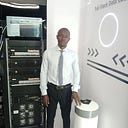Winning the Huawei ICT Competition — Regional and Global levels.
What is the Huawei Innovation Competition?
Huawei annually sponsors the Huawei ICT Competition, an international competition and exchange platform for students from all over the world, including those from Sub-Saharan Africa. Huawei hopes that by hosting this competition, students will be able to compete in a healthy manner and share their ideas, boosting their ICT knowledge and practical abilities, as well as their capacity to create by utilizing new technologies and platforms. On April 9, 2022, in Woodmead, Johannesburg, South Africa, the Huawei ICT Competition Regional Finals Award Ceremony was conducted. My three-person team and I were in attendance because we had won the Regional Grand Prize in the Innovation Track.
Problem Tackled in our Innovation
Using a design thinking method, we uncovered a critical problem — Pneumonia (Pediatric Pneumonia). It’s an acute respiratory ailment that makes it difficult for the body to breathe normally and acquire adequate oxygen. Pneumonia is responsible for 14% of all fatalities in children under the age of five, with 905, 059 children dying in 2019 and over 2,000 deaths every day (WHO, 2020). Pneumonia, on the other hand, may be prevented and treated with low-cost, low-tech medication and care if discovered early. Children who are poor, malnourished, and live in rural areas are most likely to be visited by the “forgotten killer.”
Our Solution
Pneumonia in children under the age of five is diagnosed using a number of methods in hospitals. Chest x-rays, for example, are used; however, because the newborn will be exposed to radiation, they are not recommended. The majority of Pneumonia cases are found after they have already progressed, lowering the odds of a child’s survival and increasing treatment costs.
We devised a strategy to minimize infant mortality in Sub-Saharan Africa due to pneumonia in this competition. IoT, Artificial Intelligence, and Mobile Application technologies were used to produce this solution.
Other Huawei technologies that we used were:
MindSpore is an AI computing platform that enables on-demand cooperation across the cloud-edge-device ecosystem, and was built entirely by Huawei. For model building, execution, and deployment in all situations, it offers consistent APIs and end-to-end AI capabilities. MindSpore makes use of a distributed architecture to provide higher resource efficiency, security, and trustworthiness by utilizing a native differentiable programming paradigm and novel AI native execution modes. Meanwhile, MindSpore takes full use of Ascend AI chips’ computational capacity and decreases industry AI development entrance criteria, bringing inclusive AI closer to reality faster.
Huawei Technologies’ HMS Machine Learning kit, a development tool, was used to create the AI software. This IDE plug-in includes everything you’ll need to create, code, debug, and test your own HMS Core-integrated program and publish it to the HUAWEI App Gallery.
Using a smart wearable gadget with sensors to deliver and analyze data in real- time. An Internet of Things ecosystem is made up of web-enabled smart devices that gather, send, and act on data from their surroundings using embedded systems such as CPUs, sensors, and communication gear.
By connecting to an IoT gateway or another edge device, IoT devices may share the sensor data they acquire, which can then be forwarded to the cloud or evaluated locally. These gadgets occasionally interact with one other and act on the data they receive. Although people may engage with the gadgets — for example, to set them up or give them instructions — they accomplish most of the job without human participation.
The solution was created combining both existing and emerging technology, making it a complicated and one-of-a-kind product. Because X-rays cannot be used to identify pneumonia in children under the age of 5, this posed a significant difficulty, as they are the most vulnerable. Our breakthrough gave us a once-in-a-lifetime opportunity to detect and monitor pneumonia using solely bodily factors such as blood oxygen levels, heart rate, and temperature.
Yours, Ashtone Onyango
